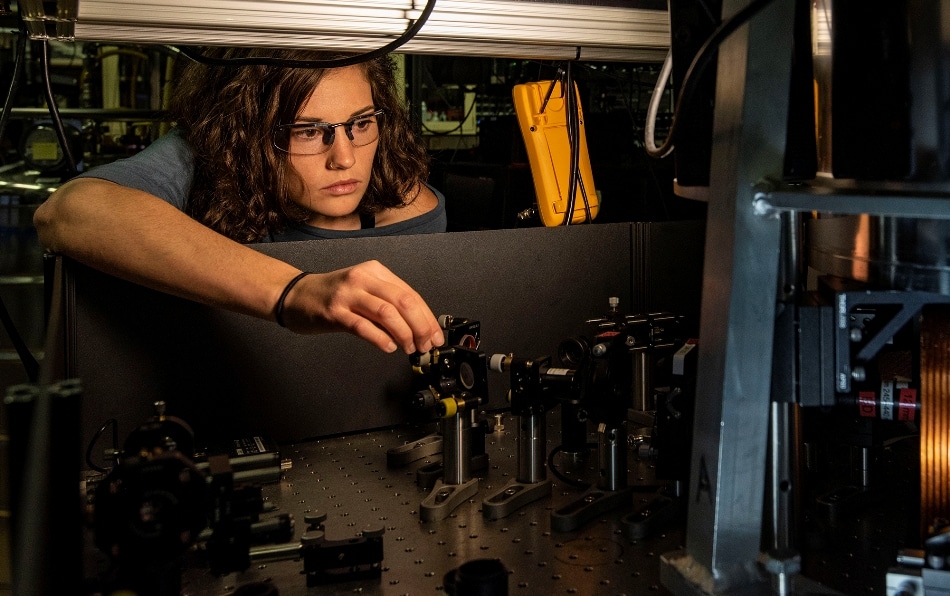Jul 23 2019
Physicists from the National Institute of Standards and Technology (NIST) have demonstrated precise control at the quantum level by developing a technique for making an ion, or electrically charged atom, exhibit accurate quantities of quantum-level motion.
 NIST physicist Katie McCormick adjusts a mirror to steer a laser beam used to cool a trapped beryllium ion (electrically charged atom). McCormick and her colleagues got the ion to display record-setting levels of quantum motion, an advance that can improve quantum measurements and quantum computing. (Image credit: J. Burrus/NIST)
NIST physicist Katie McCormick adjusts a mirror to steer a laser beam used to cool a trapped beryllium ion (electrically charged atom). McCormick and her colleagues got the ion to display record-setting levels of quantum motion, an advance that can improve quantum measurements and quantum computing. (Image credit: J. Burrus/NIST)
The quantities may be any particular amount up to 100 packets of energy or “quanta,” over five times the earlier record high of 17.
According to quantum mechanics, the fundamental theory underlying the atomic world, energy is emitted or absorbed in tiny parcels (or packets) known as quanta. Atoms emit light energy through the radiation of photons, or quanta of light. When researchers entrap the atoms, phonons, or quanta of motion, carry their motional energy.
The NIST researchers developed single numbers of quanta and also manipulated the pendulum-like motion of their ion to exhibit two distinct amounts of motional quanta at the same time: zero (minimum motion) plus any number up to 18. A “superposition” of two states such as this is a trademark of the strange quantum realm.
The new methods were reported in the Nature journal on July 22nd, 2019, and could be used with any quantum mechanical oscillator, such as systems oscillating similar to a simple pendulum or vibrating like a spring. The methods could result in new forms of quantum simulators and sensors in which phonons are used as the carriers of information.
Moreover, the potential to customize superposition states can enhance quantum information processing and quantum measurements. When compared to traditional measurements of the vibration frequency of the ion, the precision was more than doubled upon using the ion in a superposition as a frequency-measurement instrument.
If we have quantum control of an object, we can ‘bend’ classical rules to have lower uncertainties in certain desired directions at the expense of greater uncertainties in other directions. We can then use the quantum state as a ruler to measure properties of a system. The more quantum control we have, the more tightly spaced the lines on the ruler are, allowing us to measure quantities more and more precisely.
Katie McCormick, Study First Author and Physicist, NIST
The experiments were carried out with a single beryllium ion positioned 40 μm above a chilled electromagnetic trap’s gold electrodes. The new outcomes were feasible since NIST researchers could reduce undesirable factors like stray electric fields that exchange energy with and interrupt the ion, stated McCormick.
The NIST researchers added phonons to the ion by alternating ultraviolet laser pulses just above and below the frequency difference between two of the “spin” states of the ions, or internal energy configurations. The ion was flipped from “spin up” to “spin down” by each pulse or vice versa, where each flip added one quantum of ion rocking motion.
The researchers created superpositions by applying those laser pulses to just half of the wavefunction (the wavelike pattern of the probability of the spin state and location of the particle) of the ion. The wavefunction’s other half was in a third spin state that was not affected by the laser pulses and stayed motionless.
Superpositions of the motionless (or ground) state of the ion and a higher phonon number offered NIST researchers “quantum-enhanced” measurement sensitivity, or precision. They measured the oscillation frequency of the ion with an uncertainty smaller than what is usually possible by using the ion as an interferometer—an instrument that splits and merges two partial waves to form an interference pattern that can be analyzed to characterize frequency.
In particular, measurement precision rose linearly with the number of quanta of motion, right until the best performance in the 0-and-12 superposition state, thereby offering over twice the sensitivity of a classically acting quantum state (technically formed of a set of number states). The 0-and-12 superposition state also was over seven times highly precise compared to the simplest interferometer superposition of 0 and 1.
McCormick advises visualizing a wheel with spokes to know why superposition states help measure the oscillation frequency of the ion more precisely.
In a certain abstract space that describes the position and momentum of the ion, the oscillation is represented by a rotation. We want to be able to measure this rotation very precisely. Superpositions of the ion’s ground state of motion and higher number states are a great ruler for this measurement because, in this abstract representation, they can be visualized as a wheel with spokes.
Katie McCormick, Study First Author and Physicist, NIST
McCormick continued, “These spokes can be used to determine the amount by which the state has rotated. And the higher the number state, the more spokes there are and the more precisely we can measure this rotation.”
The measurement sensitivity provided by superposition states should be helpful to characterize and minimize the noise in the motion, a major source of error researchers intend to minimize in quantum information processing with trapped ions.
The study was supported by the Intelligence Advanced Research Projects Activity, the Army Research Office, and the Office of Naval Research.